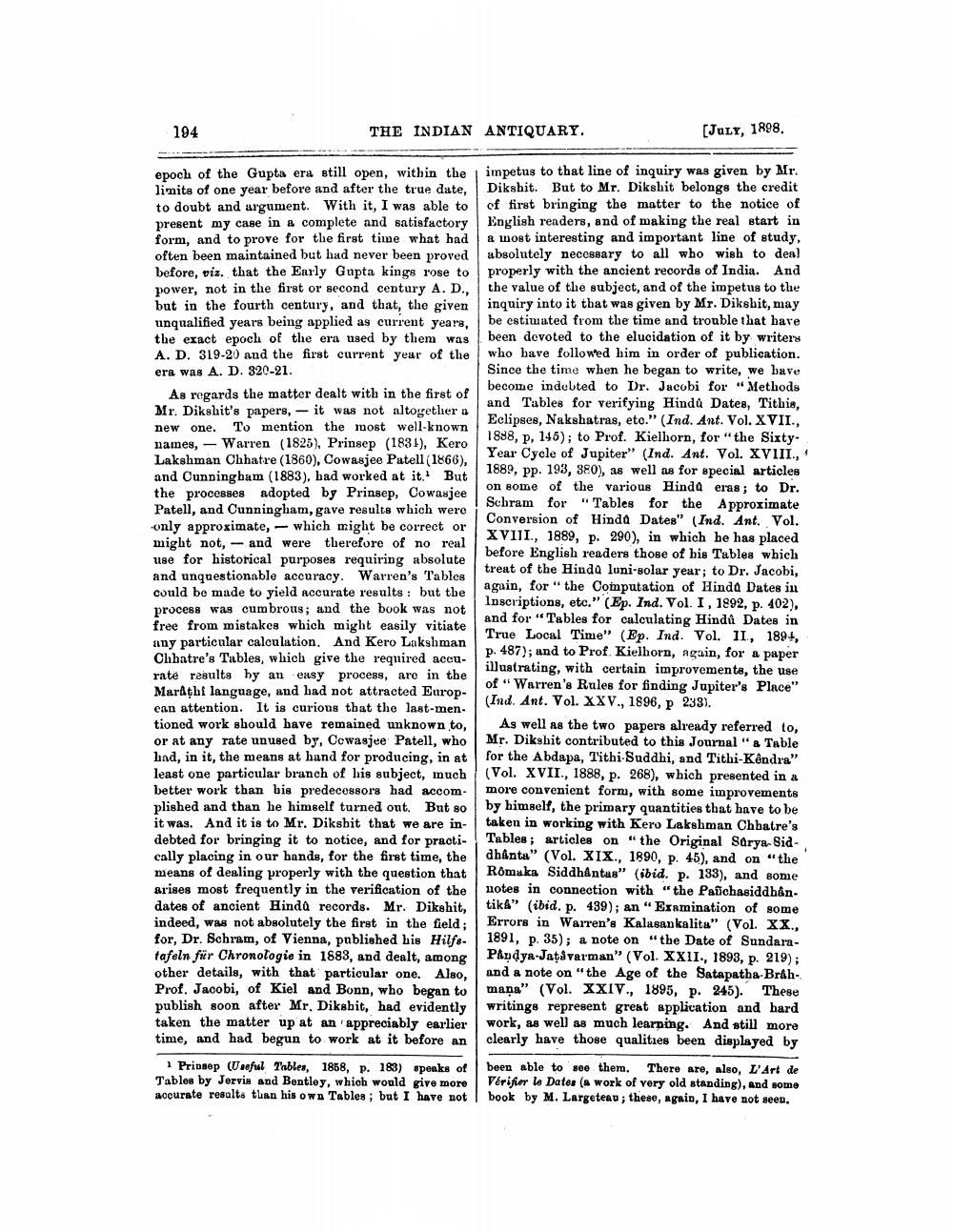________________
194
THE INDIAN ANTIQUARY.
epoch of the Gupta era still open, within the limits of one year before and after the true date, to doubt and argument. With it, I was able to present my case in a complete and satisfactory form, and to prove for the first time what had often been maintained but had never been proved before, viz. that the Early Gupta kings rose to power, not in the first or second century A. D., but in the fourth century, and that, the given unqualified years being applied as current years, the exact epoch of the era used by them was A. D. 319-20 and the first current year of the era was A. D. 320-21.
-
[JULY, 1898.
impetus to that line of inquiry was given by Mr. Dikshit. But to Mr. Dikshit belongs the credit of first bringing the matter to the notice of English readers, and of making the real start in a most interesting and important line of study, absolutely necessary to all who wish to deal properly with the ancient records of India. And the value of the subject, and of the impetus to the inquiry into it that was given by Mr. Dikshit, may be estimated from the time and trouble that have been devoted to the elucidation of it by writers who have followed him in order of publication. Since the time when he began to write, we have become indebted to Dr. Jacobi for "Methods and Tables for verifying Hindu Dates, Tithis, Eclipses, Nakshatras, etc." (Ind. Ant. Vol. XVII., 1888, p, 145); to Prof. Kielhorn, for "the SixtyYear Cycle of Jupiter" (Ind. Ant. Vol. XVIII., 1889, pp. 193, 380), as well as for special articles on some of the various Hinda eras; to Dr. Schram for "Tables for the Approximate Conversion of Hindů Dates" (Ind. Ant. Vol. XVIII., 1889, p. 290), in which he has placed before English readers those of his Tables which treat of the Hinda luni-solar year; to Dr. Jacobi, again, for" the Computation of Hinda Dates in Inscriptions, etc." (Ep. Ind. Vol. I, 1892, p. 402), and for "Tables for calculating Hindû Dates in True Local Time" (Ep. Ind. Vol. II, 1894, p. 487); and to Prof. Kielhorn, again, for a paper illustrating, with certain improvements, the use (Ind. Ant. Vol. XXV., 1896, p 233). of "Warren's Rules for finding Jupiter's Place"
As regards the matter dealt with in the first of Mr. Dikshit's papers, - it was not altogether a new one. To mention the most well-known names, - Warren (1825), Prinsep (1831), Kero Lakshman Chhatre (1860), Cowasjee Patell (1866), and Cunningham (1883), had worked at it. But the processes adopted by Prinsep, Cowasjee Patell, and Cunningham, gave results which were only approximate, which might be correct or might not, and were therefore of no real use for historical purposes requiring absolute and unquestionable accuracy. Warren's Tables could be made to yield accurate results: but the process was cumbrous; and the book was not free from mistakes which might easily vitiate any particular calculation. And Kero Lakshman Chhatre's Tables, which give the required accurate results by an easy process, are in the Marathi language, and had not attracted Europ
ean attention. It is curious that the last-mentioned work should have remained unknown to, or at any rate unused by, Cewasjee Patell, who had, in it, the means at hand for producing, in at least one particular branch of his subject, much better work than his predecessors had accomplished and than he himself turned out. But so it was. And it is to Mr. Dikshit that we are in
debted for bringing it to notice, and for practically placing in our hands, for the first time, the means of dealing properly with the question that arises most frequently in the verification of the dates of ancient Hindû records. Mr. Dikshit, indeed, was not absolutely the first in the field; for, Dr. Schram, of Vienna, published his Hilfetafeln für Chronologie in 1883, and dealt, among other details, with that particular one. Also, Prof. Jacobi, of Kiel and Bonn, who began to publish soon after Mr. Dikshit, had evidently taken the matter up at an appreciably earlier time, and had begun to work at it before an
1 Prinsep (Useful Tables, 1858, p. 183) speaks of Tables by Jervis and Bentley, which would give more accurate results than his own Tables; but I have not
As well as the two papers already referred to, Mr. Dikshit contributed to this Journal "a Table for the Abdapa, Tithi Suddhi, and Tithi-Kêndra" (Vol. XVII., 1888, p. 268), which presented in a more convenient form, with some improvements by himself, the primary quantities that have to be taken in working with Kero Lakshman Chhatre's Tables; articles on "the Original Sarya Siddhânta" (Vol. XIX., 1890, p. 45), and on "the Romaka Siddhantas" (ibid. p. 133), and some notes in connection with "the Pafchasiddhântika" (ibid. p. 439); an "Examination of some Errors in Warren's Kalasankalita" (Vol. XX., 1891, p. 35); a note on "the Date of SundaraPandya-Jatavarman" (Vol. XXII., 1893, p. 219); and a note on "the Age of the Satapatha-Bråhmana" (Vol. XXIV., 1895, p. 245). These writings represent great application and hard work, as well as much learning. And still more clearly have those qualities been displayed by been able to see them. There are, also, L'Art de Vérifier le Dates (a work of very old standing), and some book by M. Largeteau; these, again, I have not seen.




